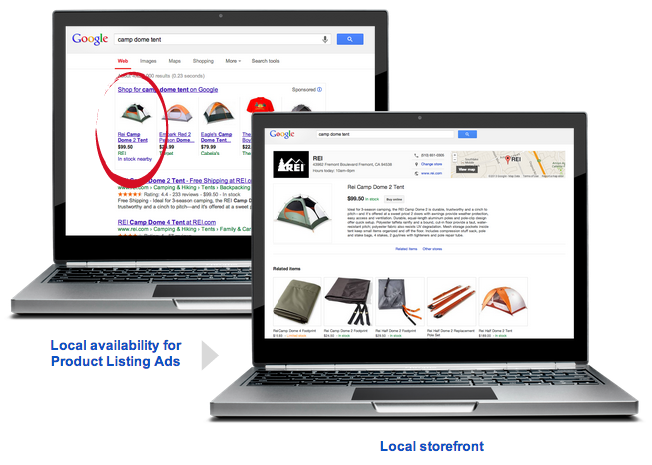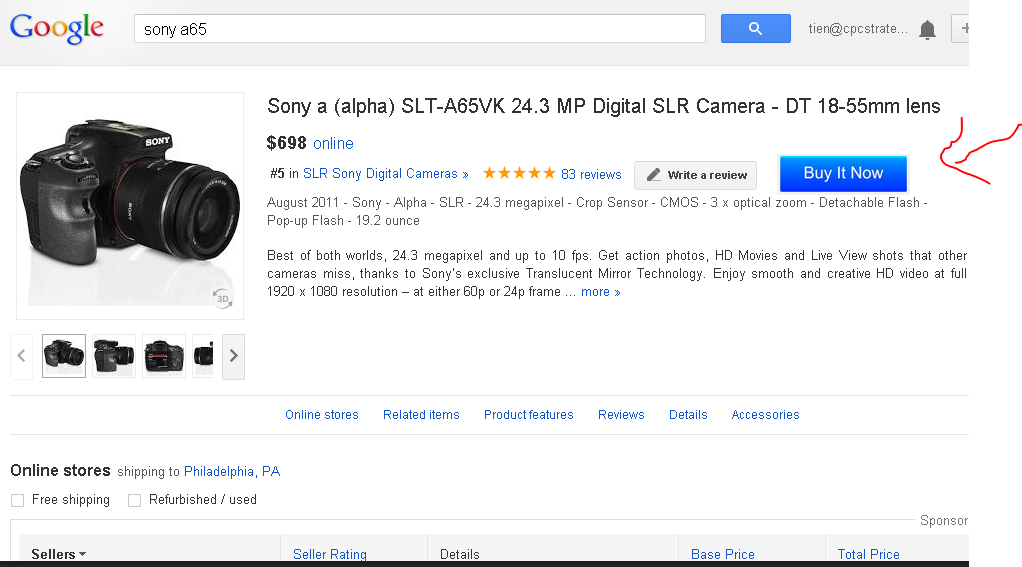Breaking News: Google Shopping Introduces Local PLAs (But Why?)

Yesterday, Google continued its optimization of the Product Listing Ads program by including 2 new features:
1) Local availability for Product Listing Ads: Search queries can now yield results that show that item’s availability at a local store.
2) A local storefront: Clicking on that local ad takes the shopper to “a local storefront”, where similar items as well as the store’s inventory are displayed. Store hours and directions are also available here.
Here’s how the progression looks on a desktop search (local ad is labeled with “in stock nearby”):

Google elaborates:
“Both local availability for Product Listing Ads and the local storefront are based on a local product feed managed through Google Merchant Center, which allows retailers to provide users with up-to-date, item-level price and availability information for each physical store. Participating retailers pay for clicks on the Product Listing Ad to the local storefront on a cost-per-click (CPC) basis. All clicks and interactions on the local storefront are free. Retailers can also see separate local click performance.”
These local ads, however, are not available to everyone yet. If you have a B&M store and are looking to participate, you can fill out this interest form. View the full Google press release here.
These 2 new features combine to support one thing: offline purchases at a local store.
A logical question is, “Why would Google, who’s shown a large interest and involvement in ecommerce in the past year, be interested in promoting offline purchases?”
Our experts weighed in. The general conclusion? Google continues to make strides towards an eventual Google Marketplace. Oh, and they like to make money, too.
 Our Co-Founder & CEO, Rick Backus, explains:
Our Co-Founder & CEO, Rick Backus, explains:
“When you combine Google Shopping storefronts with local availability, a quickly developing Google Shopping Express program, and Google Wallet, you have a rough foundation for what could eventually be an integrated marketplace similar to Amazon’s but with the local availability feature.
That feature is huge because the bigger opportunity is offline commerce since that’s where 90% of retail purchases still take place. Wait till your Mom finds out that she can use Google Shopping Express for her local Target purchases instead of fighting the crowds after a long day of work. And if she’s using Google Shopping Express, Google can take a cut of the transaction from both the user and the seller.”
Co-Founder and Director of Technology, Tien Nguyen, sees a Google Marketplace as looking very similar to PLAs now, just with a Google Wallet-linked “Buy It Now” functionality:


Nii Ahene, Co-Founder and COO, proclaims, “I don’t see a world where Google ever takes physical inventory via warehouses. Would Google get paid 100% of the purchase price and pass a percentage back to the retailer (with fees taken out)?”
Rick: “The fulfillment part would be a big issue for Google and I don’t think they could compete with Amazon’s efficiency. I agree that Google won’t ever have warehouses, which is the main reason why the Amazon Marketplace will continue to be a superior online shopping experience. Google won’t have the systems to vet, penalize, and kick off low-quality sellers.”

Tien: “Yeah Google is good at connecting consumer A with business B. For example, if Google expands upon the Express model and targets huge retailers like Target, Toys R Us, Best Buy, Sears, Michael’s etc. (who already have the infrastructure in place for shipping and tons of local B&M stores), you’d imagine that those big guys would jump at the opportunity to be on there.
Imagine if you’re Best Buy and someone searches for an Apple Macbook on Google and there’s a “Buy It Now ” button that would relay that information to you. From there Google could expand out to the Zaggs of the world (huge but non-mainstream retailers) who can deliver stellar service. Google could rely on reputable retailers to handle the dirty work and so it would never have to own a warehouse.
Wild prediction: Google teams up with Shoprunner/GSI/ebay to take down Amazon.”
Rick: “The big vision is a world where users start and end their product searches on Google. It doesn’t matter whether the customer makes the purchase online or offline, Google just wants to own the experience.”
Needless to say, big things are coming for Google Product Listing Ads.
